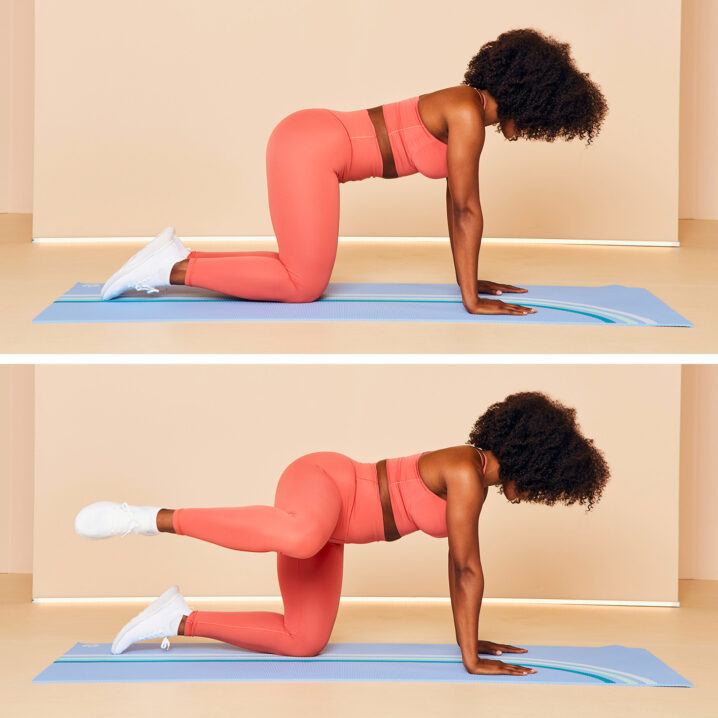
- POPSUGAR Australia
- Fitness
- Want to Build Your Glutes, But Sick of Squats? Meet the Fire Hydrant Exercise
Want to Build Your Glutes, But Sick of Squats? Meet the Fire Hydrant Exercise

The fire hydrant exercise has been around at least since the days of Jane Fonda workout tapes, but it’s not just your mama’s exercise – it’s something you should consider adding to your routine as well. Fire hydrants are a great exercise because they don’t require any equipment, but can still help you build some serious glute strength.
Fire hydrants target your gluteus medius (think the side of your butt). “This muscle can be overshadowed in training, since many people focus on their gluteus maximus, the main part of your butt”, says Domenic Angelino, a certified personal trainer with Trainer Academy. “The gluteus maximus still will experience a training effect here, but it won’t be as profound as the gluteus medius.” So, no – the fire hydrant is not a replacement for squats. But it can be a great alternative, since it works related but different muscles.
The benefit of having a strong gluteus medius is to be able to move the body in a lateral direction, or side to side. This is helpful not only for athletes who need lateral agility, but also for everyday life when you need to move out of the way quickly, like maneuvering your way through a busy airport.
Fire Hydrant Exercise Benefits
Again, the fire hydrant is an incredibly effective glute move. Here, three benefits of the lower-body exercise.
They Don’t Require Equipment
The fire hydrant is a great way to train your glutes without needing access to go to a gym. Lack of equipment can be a barrier when it comes to working out, but with the fire hydrant, all you need is your bodyweight. “This is huge, because a lot of people struggle to maintain motivation to workout consistently. Since motivation comes in waves and is transient, it’s important to have tools at your disposal to capitalize on those bursts of motivation. Having a way to workout on the spot is a great way to do this”, says Angelino. This also means you can keep up with your fitness routine anywhere.
(That said, you can up the intensity of the move by adding on an exercise band – more on that below.)
They’re Accessible
The fire hydrant is simplistic. “They’re structured in such a way that most people will be able to lift their leg up appropriately, even if only through a partial range of motion,” Angelino explains. Though you do want to use your maximum range of motion, it does not need to be a large range of motion to be effective.
They’re a Perfect Finisher
When you’ve reached the end of a workout where you’ve used heavy loads, and want to do a final burnout round to push your muscle endurance, the last thing you want to think about is lifting more heavy weight. Enter the fire hydrant. “Since they rely on a single joint, they can be tagged on to a workout after completing more challenging exercises that involve multiple joints”, Angelino tells PS.
How to Do a Fire Hydrant
- Start on all fours with your wrists under your shoulders, and your knees under your hips.
- Keeping the left knee on the ground, lift your right leg up, opening up the hip.
- Bring your right leg up to 90 degrees, or as high as your range of motion allows while keeping your hips parallel to the floor.
- Return your right leg back to the starting position.
- Repeat for 10 reps.
- Complete 10 reps on the left leg.
An important note is to make sure you keep your hips square to the floor and not let your torso twist. Twisting the body will start to recruit the abdominals and take away from the activation of the glutes.
Fire Hydrant Modifications and Variations
One reason trainers love fire hydrants is because they’re so adaptable. You can start with a smaller range of motion when you’re still newer to the move; or wear a resistance band to make it more challenging. Here, more info about how to modify the exercise.
Try a Clamshell
The clamshell exercise trains similar muscles to the fire hydrant, so it can be a good place to start if you’re struggling with the fire hydrant, Angelio says.
You can find the steps for performing a clamshell here. Basically, you’ll lay on your side with your hips, knees and ankles stacked. Lift your top knee, and open your hips as far as your range of motion allows, then return to the starting position.
Add a resistance band
When adding a resistance band to your fire hydrant, slip a closed band around your legs, placing it about two inches above your knee. Then perform a fire hydrant as normal.
Add a pulse
Another way to get more of a muscle burn is to add a pulse to the top of the fire hydrant movement. Raise your leg to the top of your range of motion. Then lower your leg an inch, then lift it an inch, and repeat for 10-20 reps. This creates more time under tension, which helps to build the muscle.
Brittany Hammond is a NASM-certified fitness instructor, a fitness writer, and an avid reader. In addition to POPSUGAR, she has contributed to Livestrong.com, Well+Good, Verywell Fit, and Health.com. She has worked as a group fitness coach for the past seven years.

